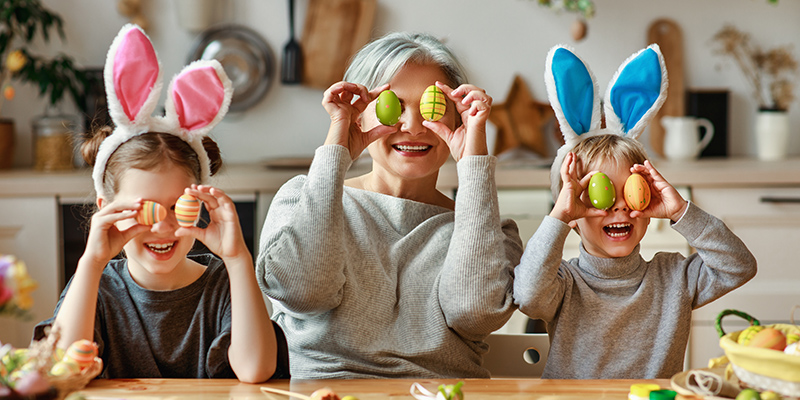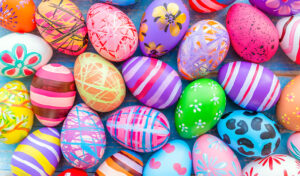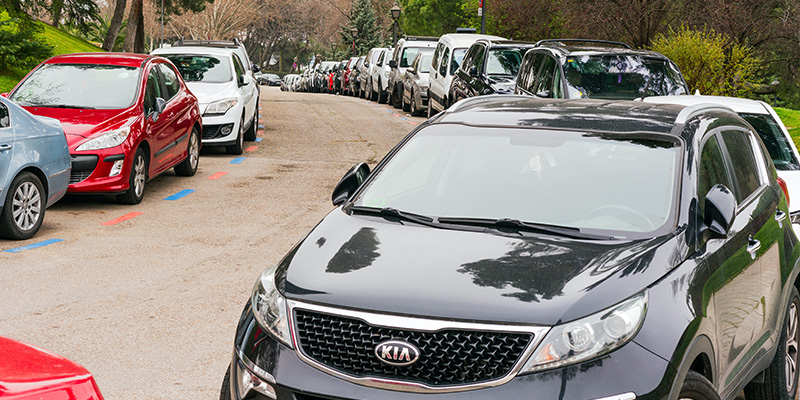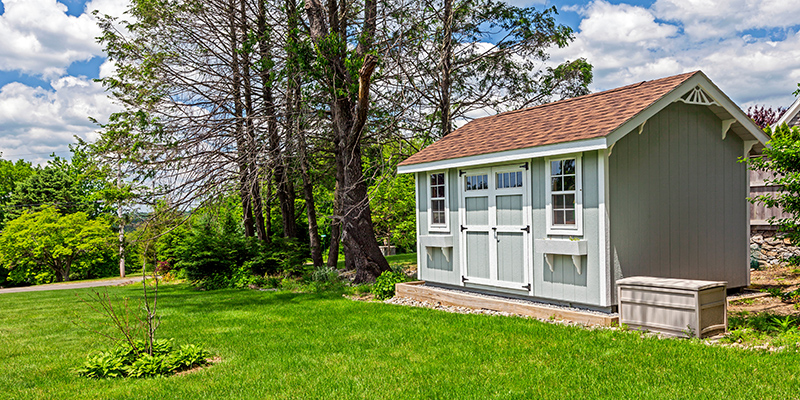5 Fun And Creative Ways To Make Easter Eggs

Easter is just around the corner, which means it's almost time to break out the food coloring and do some decorating. Here are some of the best ways to make Easter eggs.
Browse By Category
Sign up for Our Newsletter
Easter is just around the corner, which means it’s almost time to break out the food coloring and do some decorating. Here are some of the best ways to make Easter eggs.
How to Make Easter Eggs
Eggs are a staple during the Easter season. Next to candy, eggs see the largest boost in sales around this time, with 180 million eggs purchased for Easter every year. Considering how much fun families can have while decorating Easter eggs together, this is unsurprising. Instead of buying pre-decorated or plastic eggs, making Easter eggs at home offers a truly memorable experience for everyone.
But how do you make these colorful eggs in the first place? You don’t need a rocket scientist to know how to make Easter eggs with real eggs, and all you need to do is boil them.
Place the eggs in a large pot and cover them with enough water to do this. Bring the water to a boil over medium-high heat. Once you reach a rolling boil, cover the pot and remove it from the heat. Let the eggs sit in hot water for about 10 minutes. After that, drain the pot and dunk the eggs in ice water.
Next comes the fun part — decorating. If you’re tired of the same old designs, why not try something new? Here’s how to do Easter eggs in five creative ways.
1. Marbled Eggs
Materials:
- Hardboiled eggs
- Vegetable oil
- White vinegar
- Food coloring
- Mugs (one per color)
- Spoons (one per color)
Directions:
- Mix a tablespoon of white vinegar and a tablespoon of oil into every mug. Add a different color of food coloring into each mug — use as many colors as you like. Pour water into the mugs, filling them about 3/4 of the way through. Stir.
- Have a hardboiled egg ready on hand. Using your other hand, stir the mug vigorously so that it creates a whirlpool. Remove the spoon quickly before placing the egg on the spoon and lowering it into the colored water.
- Hold the egg in the swirling water for 5 to 6 seconds. Remove the egg.
- Transfer the egg to a paper towel and let it air dry. Don’t pat it down with a paper towel. Let it rest for several minutes. Repeat the coloring process, using a different color this time around. You can mix and match colors or even just use one color. Once you’re satisfied with the look, pat it down gently with a paper towel to remove the excess moisture.
- Repeat with the other eggs.
2. Drip Eggs
Drip eggs are one of the easiest Easter egg DIY projects. You only need a few things, some patience, and you’re done!
Materials:
- Hardboiled eggs
- Food coloring
- Egg holder
- Spray bottle of water
Directions:
- Place an egg into an egg holder or cup. Spray the top of the egg with a little water.
- Drop a little food coloring onto the top of the egg.
- From a distance, spray the top again with water.
- Add more colors using the same drip method.
- Spray the top again with water until you’re happy with the results.
- Let dry and repeat with other eggs.
3. Speckled Eggs
Materials:
- Hardboiled eggs
- White vinegar
- Food coloring
- Mugs (one per color)
- Spoons (one per color)
- Water
- Newspaper
- Old toothbrush
- Brown craft paint
Directions:
- Mix a tablespoon of white vinegar and a tablespoon of oil into every mug. Add a different color of food coloring into each mug — use as many colors as you like. Pour water into the mugs, filling them about 3/4 of the way through. Stir.
- Dye the eggs by leaving them in the mugs. If you want a deeper color, immerse the eggs for longer. Let the eggs dry fully.
- In a separate mug, combine a teaspoon of brown paint and about 4-5 drops of water. Lay down some newspaper to avoid making a mess.
- Place the eggs down on the newspaper. Wet your old toothbrush and get rid of the excess moisture. Dip the toothbrush, bristle-side down, into the brown paint and water mixture. Hold the toothbrush from a distance, pointing the bristles of the toothbrush in a downward position. Run your finger across the bristles to flick the paint onto the eggs, creating a speckled effect.
- Allow the eggs to dry before repeating step 4 on the other side of the eggs.
Tip: It’s better to practice the flicking method on the newspaper first. Once you’ve got the technique down, you can try with the eggs.
4. Silk Tie Eggs
Materials:
- Raw white eggs
- 100% silk ties or material
- White cotton fabric
- Plain white string or rubber bands
- White vinegar
- Water
- Low stockpot
- Paper towels
- Baking sheet
Directions:
- Cut the silk ties into large enough pieces to cover the eggs. Wrap each egg with a piece of silk fabric, careful not to crack the eggs in the process. Smooth out any creases or wrinkles before wrapping it again with a piece of white cotton fabric. Secure the fabrics with a rubber band or white string.
- Place the eggs into a low stockpot. Pour cold water to more than cover the eggs. Add 6 tablespoons of white vinegar. Turn the heat on the medium and bring the water to a boil. Let it cook for 20 minutes minimum. Once done, remove the eggs and transfer them to a paper towel-lined baking sheet. Let them cool completely before moving to the next step.
- Remove the fabrics wrapping each egg. You might need to use scissors to cut them out. Never reuse the silk fabric on another egg since the design has already been transferred. Pat the eggs dry with a paper towel. As a finishing touch, rub some vegetable oil over each egg to give them a nice shine.
5. Natural Dyed Eggs
Food coloring isn’t exactly the most natural source of pigment, and silk ties can be expensive. If you want to make marbled, speckled, or drip eggs but don’t have food coloring lying around, you can always make your own dyes. Here’s how to make dye for Easter eggs using natural ingredients.
Materials/Ingredients and Directions:
- Hardboiled eggs
- Jars (with wide mouths)
For blue dye: Chop red cabbage into chunks and combine with 4 cups of boiling water. Add 2 tablespoons of vinegar. Let it reach room temperature before removing the chunks of cabbage. Add the hardboiled eggs.
For green dye: Peel 6 red onions and simmer in 2 cups of water for about 15 minutes. Remove the onions before adding 3 teaspoons of white vinegar. Add the hardboiled eggs.
For green-yellow dye: Peel 6 yellow apples and simmer in 1 1/2 cups of water for about 20 minutes. Remove the apples before adding 2 teaspoons of white vinegar. Do the same with 4 ounces of chopped fennel tops.
For orange dye: Peel 6 yellow onions. Simmer the skin in 2 cups of water for about 15 minutes. Remove the skin and add 3 teaspoons of white vinegar. Add the hardboiled eggs.
For red-orange dye: Combine 1 cup of boiling water and 2 tablespoons of paprika. Add 2 teaspoons of white vinegar before adding the hardboiled eggs.
For brown dye: Combine 1 cup of strong coffee and 1 tablespoon of vinegar. Add the hardboiled eggs.
For lavender dye: Combine 1 cup of grape juice and 1 tablespoon of vinegar. Add the hardboiled eggs.
You can leave the hardboiled eggs in the jars for as long or as short as you want. Keep in mind that you’ll achieve better results when you leave the eggs in for longer (at least overnight).
 How to Make Chocolate Easter Eggs
How to Make Chocolate Easter Eggs
The easiest way to incorporate chocolate into your Easter celebration is to fill plastic eggs with chocolate candy. But if you want to take it to the next level, why not make an egg entirely from chocolate? Here’s how you can do that.
- Melt chocolate over a double boiler or in the microwave.
- Lightly grease an Easter egg mold with vegetable oil.
- Pour the melted chocolate into the prepared mold, making sure all the sides are covered. Do this with both parts of the mold.
- Turn the mold over to get rid of the excess chocolate. Do this over your bowl of melted chocolate, so you don’t waste any.
- Join the molds together to form the egg shape. Secure the mold with clips. Give it a good shake to make sure everything’s covered.
- Set the mold aside for 5 minutes. After 5 minutes, turn the mold over once. Set aside to harden.
- Place the mold in the fridge for about 5 to 10 minutes before removing the clips and releasing the chocolate egg.
 Have an Egg-cellent Easter!
Have an Egg-cellent Easter!
As you can see, it is easy to make Easter eggs so long as you have the right materials. If you’ve never made Easter eggs yourself before, now is the time to start. It’s a great activity for any group of people — family, friends, and even strangers!
RELATED ARTICLES:
- 7 Easter Community Service Ideas
- 9 HOA Fourth Of July Celebration Ideas To Bring The Community Together
- Are HOA Trash Cans Becoming A Problem?
Trending Now
Related Article
Sign up for Our Monthly Newsletter
Sign up below for monthly updates on all HOA Resource
















